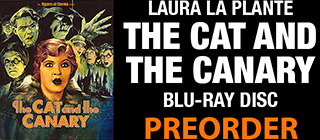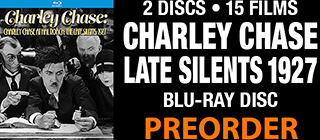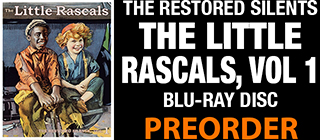Silent Era Home Page > Home Video > Max Fleischer’s Famous Out of the Inkwell

Reviews of silent film releases on home video.
Copyright © 1999-2024 by Carl Bennett
and the Silent Era Company.
All Rights Reserved. |
|
Out of the Inkwell
(1919-1933)
|
Contents: The Tantalizing Fly (1919), The Ouija Board (1920), The Clown’s Little Brother (1920), Perpetual Motion (1920), Modeling (1921), Bubbles (1922), Ko-Ko in Toyland (1925), In the Good Old Summer Time (1926), Betty Boop’s Ker-Choo (1933), Betty Boop’s Crazy Inventions (1933) and Is My Palm Read (1933)
Max Fleischer was an innovator to early cinema fans. He is a god to early animation buffs. Many film enthusiasts are familiar with Fleischer’s Betty Boop, Popeye and Superman cartoons of the Golden Age, but few of the general population are aware of his pioneering animation work in the silent era.
Fleischer developed and held patents on several animation and film production processes, including rotoscoping, a process whereby a live subject is photographed and used as the model for lifelike animated drawings.
Fleischer’s brother Dave, a part-time professional clown, became the world’s first rotoscope model when Max created a clown cartoon character, that would come to be known as Ko-Ko, during his early years working for J.R. Bray’s cartoon studios.
From the beginning, the pattern of Ko-Ko cartoons was established: Max (in live-action footage) would draw Ko-Ko (in stop-motion animation), who would come to life and cause no end of trouble (in full-animation). Ko-Ko usually ended up dribbling back into the ink bottle from whence he came — by force or of his own will — to end each cartoon.
Before long (with the coaxing of brother Dave), Max established the Out of the Inkwell animation studio and continued his successful run of Ko-Ko cartoons, delighting Inkwell fans with the little clown’s mischievous exploits.
During the 1920s, Max Fleischer created the famous bouncing ball sing-along films (that occasionally graced locally-produced television cartoon shows well into the 1960s), and he also became the first cartoon producer to synchronize recorded sound with animated films (employing the DeForest Phonofilm sound system), years before it was done by rival animator Walt Disney.
— Carl Bennett
|
 Alpha Video Alpha Video
2020 DVD edition
Out of the Inkwell (1919-1933), black & white, 64 minutes total, not rated, including The Tantalizing Fly (1919), black & white, ? minutes, not rated, The Ouija Board (1920), black & white, ? minutes, not rated, The Clown’s Little Brother (1920), black & white, ? minutes, not rated, Perpetual Motion (1920), black & white, ? minutes, not rated, Modeling (1921), black & white, ? minutes, not rated, Bubbles (1922), black & white, ? minutes, not rated, Ko-Ko in Toyland (1925), black & white, ? minutes, not rated, In the Good Old Summer Time (1926), black & white, ? minutes, not rated, Betty Boop’s Ker-Choo (1933), black & white, ? minutes, not rated, Betty Boop’s Crazy Inventions (1933), black & white, ? minutes, not rated, and Is My Palm Read (1933), black & white, ? minutes, not rated.
Alpha Home Entertainment, distributed by Oldies.com,
ALP 8301D, UPC 0-89218-83019-7.
One single-sided, single-layered, Region 0 NTSC DVD-R disc, 1.33:1 aspect ratio image in full-frame 4:3 (720 x 480 pixels) interlaced scan MPEG-2 format, SDR (standard dynamic range), ? Mbps average video bit rate, ? Kbps audio bit rate, Dolby Digital 48 kHz 2.0 mono sound, English language intertitles, no subtitles; chapter stops; standard DVD keepcase; $7.98 (raised to $8.98).
Release date: 14 January 2020.
Country of origin: USA
|
|
This DVD-R collection of eight early animation films by Max Fleischer may have been mastered from 16mm and 8mm reduction prints.
The Tantalizing Fly (1919) features a pesky fly that irritates both Max and Ko-Ko the clown.
The Ouija Board (1920) finds Ko-Ko disturbed by ghosts while Max deals with Ouija-board-reading employees. Ko-Ko then haunts the studio. This is one of the few times that Ko-Ko doesn’t end up back in the inkwell.
The Clown’s Little Brother (1920) brings news of Ko-Ko’s little brother arriving by parcel post. On arrival, the brother becomes a pest for Ko-Ko and Max.
Perpetual Motion (1920) features a perpetual motion machine that Max arranges to buy from its inventor, only to find that he has been boondoggled by Ko-Ko.
Modeling (1921) is the first of the cartoons in this collection produced for Fleischer’s own company and features Max with a fussy clay sculpture model. Ko-Ko adds his own brand of mischief.
Bubbles (1922) begins with Max and Ko-Ko blowing bubbles. Whaddaya know? It soons escalates into a bubble battle and a chase.
Ko-Ko in Toyland (1925) finds Ko-Ko getting into his typical mischief.
In the Good Old Summer Time (1926) is one of 17 silent Song Car-Tunes films that were originally intended for live theater musical accompaniment. This print may be a rerelease, post-synchronized sound film utilizing the RCA Photophone sound-on-film sound system.
The films are likely accompanied by soundtracks compiled from preexisting recordings.
The supplemental material includes three Betty Boop cartoons from 1933 that may not have appeared on home video before.
We haven’t yet viewed this edition and thus cannot recommend it, especially since the majority of the films have been available for years in other DVD home video editions.
|
|
This
Region 0 NTSC DVD-R edition is also available directly from . . .
|

|
|
|
Other silent era MAX FLEISCHER films available on home video.
Other ANIMATION FILMS of the silent era available on home video.
|
|

LINKS IN THIS COLUMN
WILL TAKE YOU TO
EXTERNAL WEBSITES
•
SUPPORT SILENT ERA
USING THESE LINKS
WHEN SHOPPING AT
AMAZON



•











•
|




































